TOYOTA TUNDRA 2023 Owners Manual
Manufacturer: TOYOTA, Model Year: 2023, Model line: TUNDRA, Model: TOYOTA TUNDRA 2023Pages: 616, PDF Size: 11.14 MB
Page 181 of 616
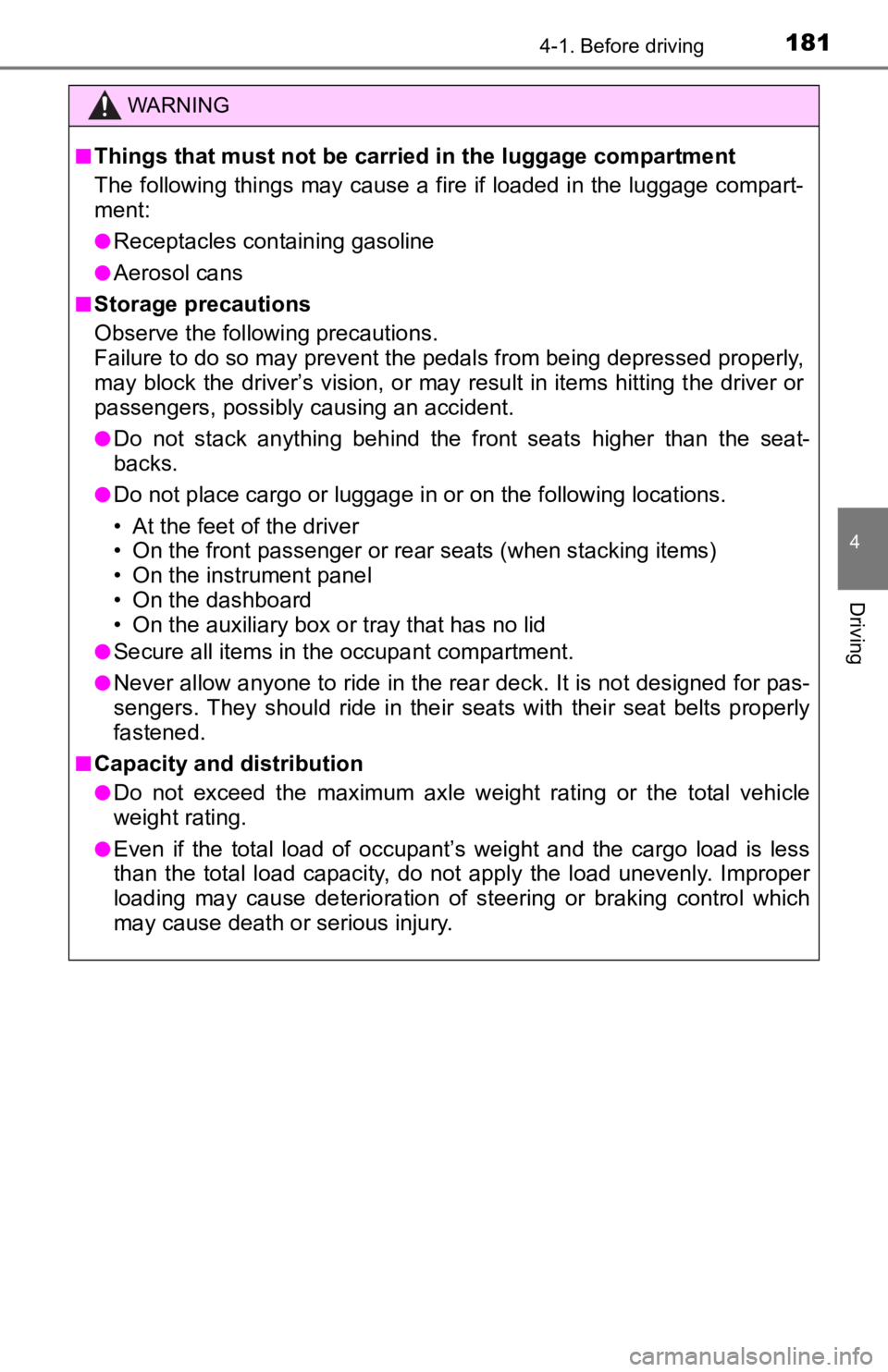
1814-1. Before driving
4
Driving
WARNING
■Things that must not be carried in the luggage compartment
The following things may cause a fire if loaded in the luggage compart-
ment:
●Receptacles containing gasoline
●Aerosol cans
■Storage precautions
Observe the following precautions.
Failure to do so may prevent the pedals from being depressed pr operly,
may block the driver’s vision, or may result in items hitting t he driver or
passengers, possibly causing an accident.
●Do not stack anything behind the front seats higher than the se at-
backs.
●Do not place cargo or luggage in or on the following locations.
• At the feet of the driver
• On the front passenger or rea r seats (when stacking items)
• On the instrument panel
• On the dashboard
• On the auxiliary box or tray that has no lid
●Secure all items in the occupant compartment.
●Never allow anyone to ride in the rear deck. It is not designed for pas-
sengers. They should ride in their seats with their seat belts properly fastened.
■Capacity and distribution
●Do not exceed the maximum axle weight rating or the total vehic le
weight rating.
●Even if the total load of occupant’s weight and the cargo load is less
than the total load capacity, do not apply the load unevenly. I mproper
loading may cause deterioration of steering or braking control which
may cause death or serious injury.
Page 182 of 616
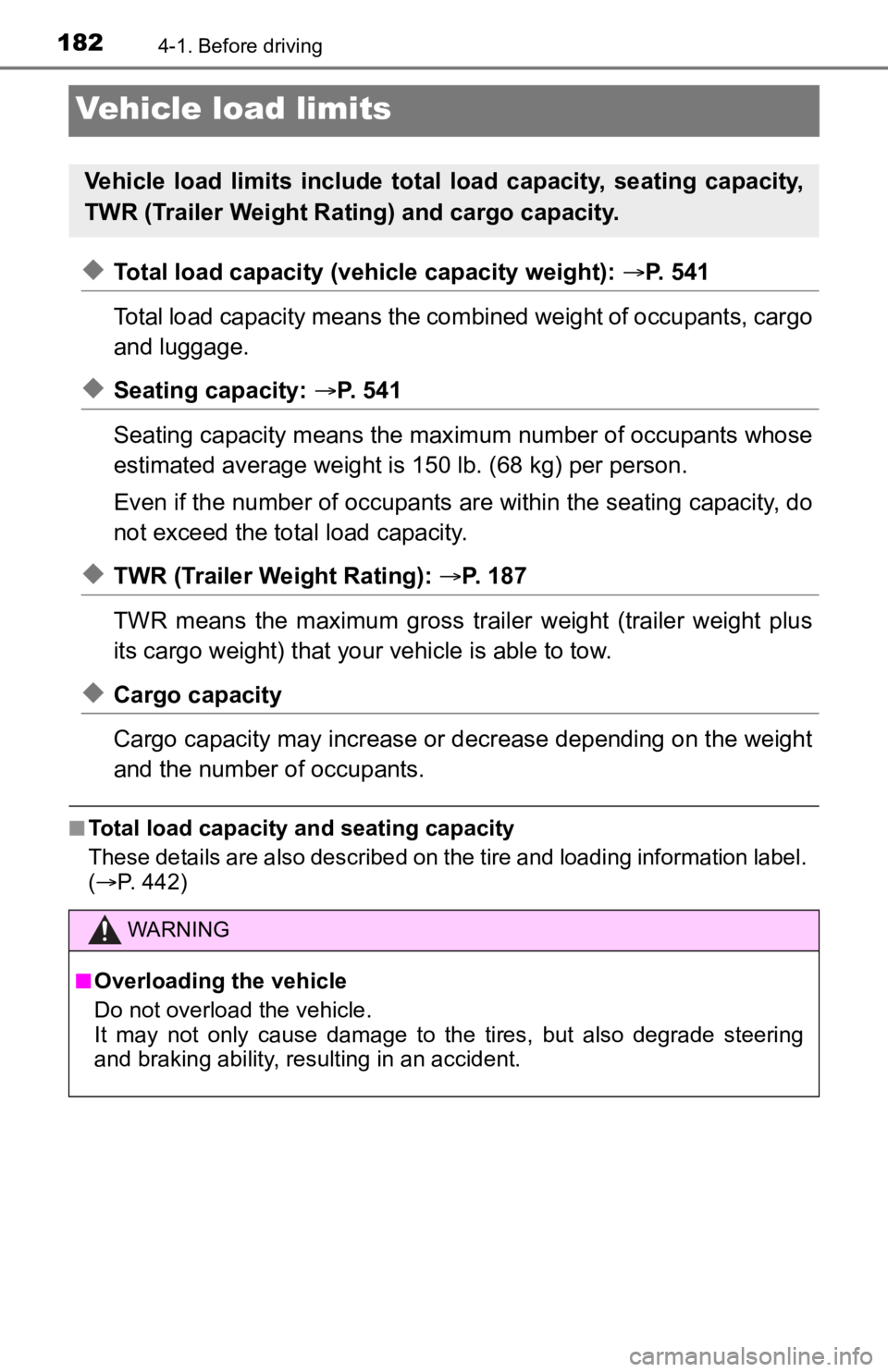
1824-1. Before driving
Vehicle load limits
◆Total load capacity (vehicle capacity weight): P. 541
Total load capacity means the co mbined weight of occupants, cargo
and luggage.
◆Seating capacity: P. 5 4 1
Seating capacity means the max imum number of occupants whose
estimated average weight is 150 lb. (68 kg) per person.
Even if the number of occupants are within the seating capacity , do
not exceed the tota l load capacity.
◆TWR (Trailer Weight Rating): P. 187
TWR means the maximum gross trai ler weight (trailer weight plus
its cargo weight) that your vehicle is able to tow.
◆Cargo capacity
Cargo capacity may increase or decrease depending on the weight
and the number of occupants.
■Total load capacity and seating capacity
These details are also described on the tire and loading information label.
( P. 442)
Vehicle load limits include total load capacity, seating capaci t y,
TWR (Trailer Weight Rati ng) and cargo capacity.
WARNING
■
Overloading the vehicle
Do not overload the vehicle.
It may not only cause damage to the tires, but also degrade steering
and braking ability, resulting in an accident.
Page 183 of 616
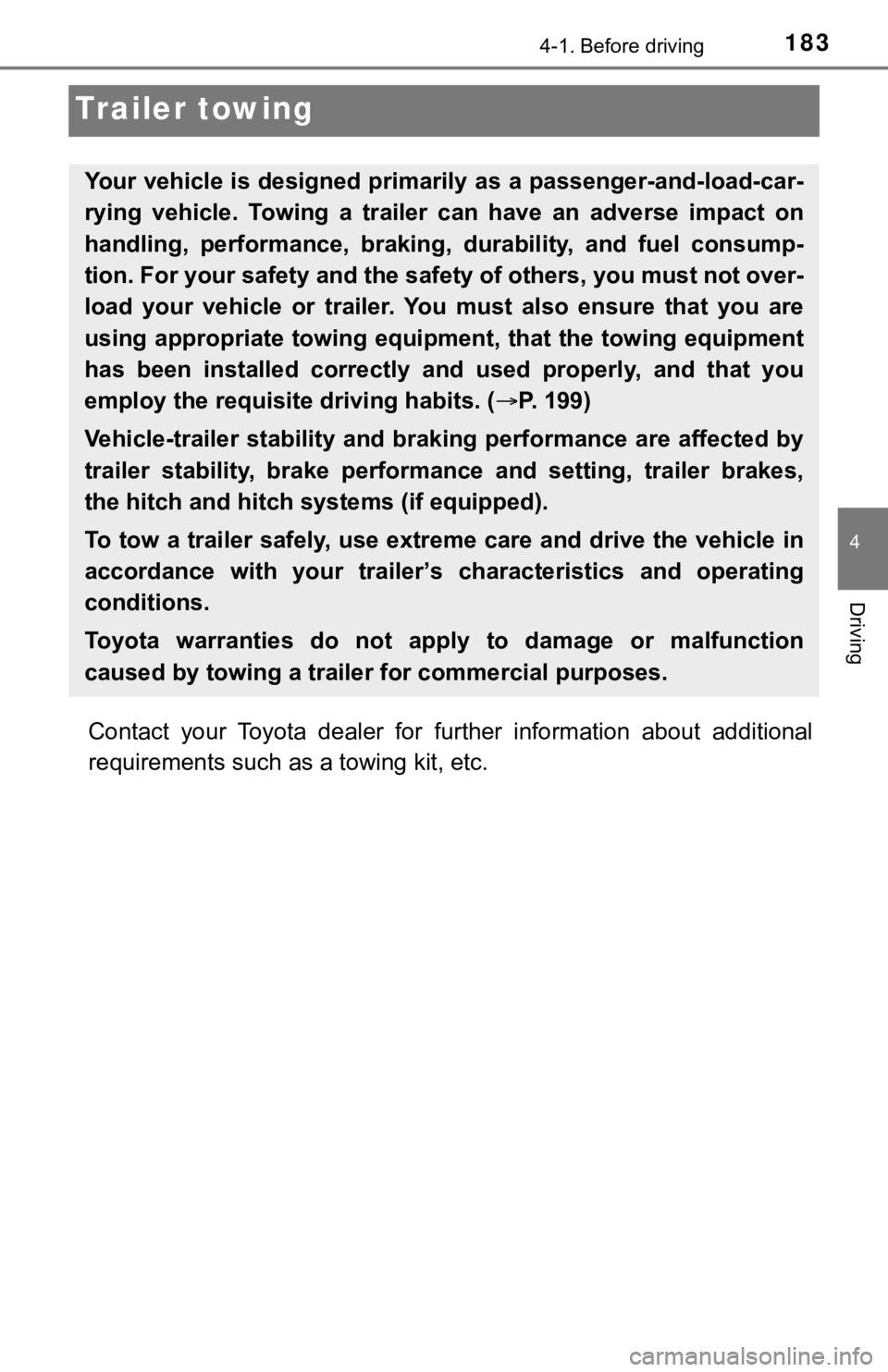
1834-1. Before driving
4
Driving
Trailer towing
Contact your Toyota dealer for further information about additi onal
requirements such as a towing kit, etc.
Your vehicle is designed primarily as a passenger-and-load-car-
rying vehicle. Towing a trailer can have an adverse impact on
handling, performance, braking, durability, and fuel consump-
tion. For your safety and the safety of others, you must not ov er-
load your vehicle or trailer. You must also ensure that you are
using appropriate towing equipm ent, that the towing equipment
has been installed correctly a nd used properly, and that you
employ the requisite driving habits. (P. 199)
Vehicle-trailer stability and braking performance are affected by
trailer stability, brake performance and setting, trailer brake s,
the hitch and hitch systems (if equipped).
To tow a trailer safely, use extreme care and drive the vehicle in
accordance with your trailer’s characteristics and operating
conditions.
Toyota warranties do not apply to damage or malfunction
caused by towing a trailer for commercial purposes.
Page 184 of 616
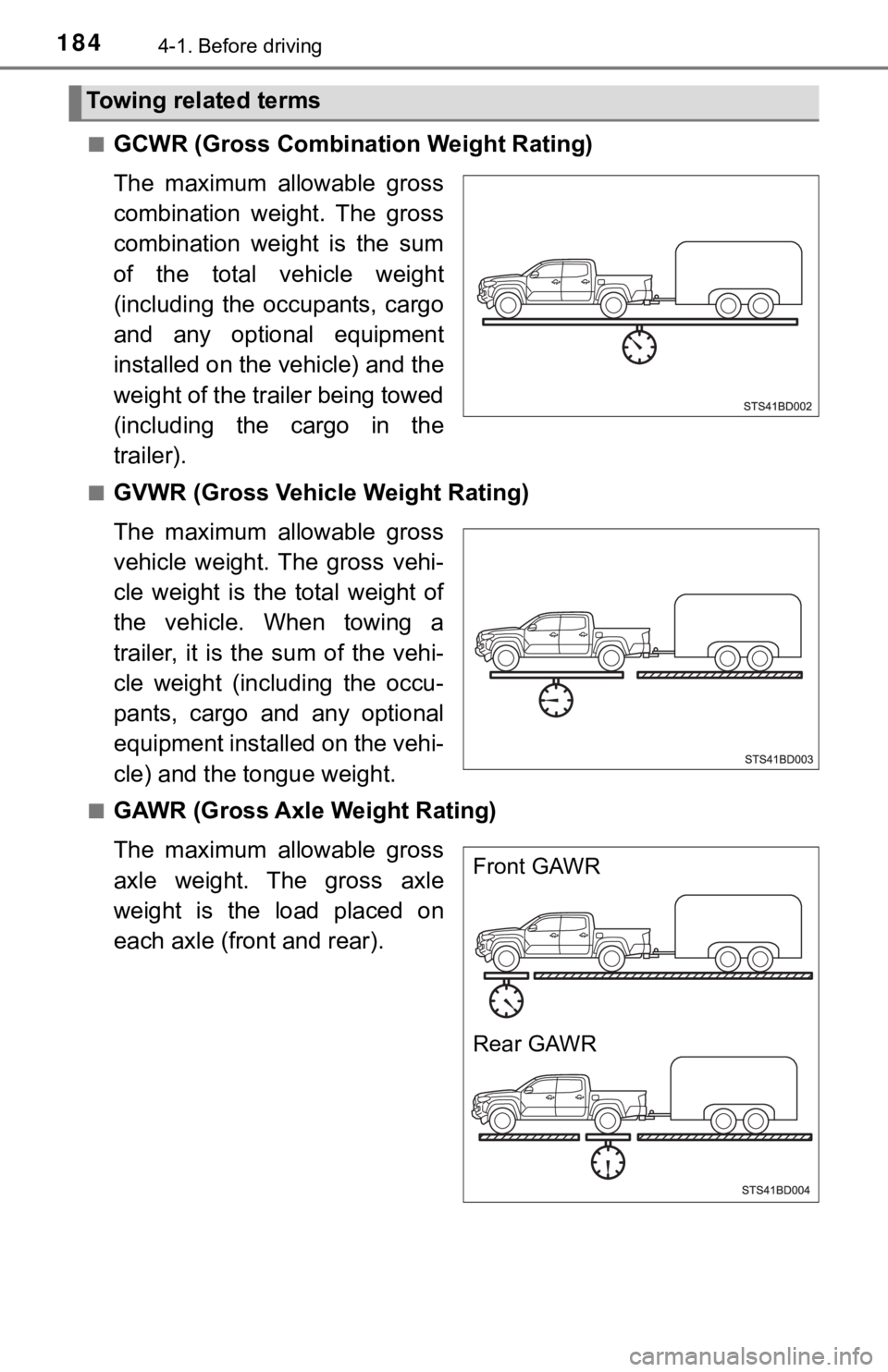
1844-1. Before driving
■GCWR (Gross Combination Weight Rating)
The maximum allowable gross
combination weight. The gross
combination weight is the sum
of the total vehicle weight
(including the occupants, cargo
and any optional equipment
installed on the vehicle) and the
weight of the trailer being towed
(including the cargo in the
trailer).
■GVWR (Gross Vehicle Weight Rating)
The maximum allowable gross
vehicle weight. The gross vehi-
cle weight is the total weight of
the vehicle. When towing a
trailer, it is the sum of the vehi-
cle weight (including the occu-
pants, cargo and any optional
equipment installed on the vehi-
cle) and the tongue weight.
■GAWR (Gross Axle Weight Rating)
The maximum allowable gross
axle weight. The gross axle
weight is the load placed on
each axle (front and rear).
Towing related terms
Front GAWR
Rear GAWR
Page 185 of 616
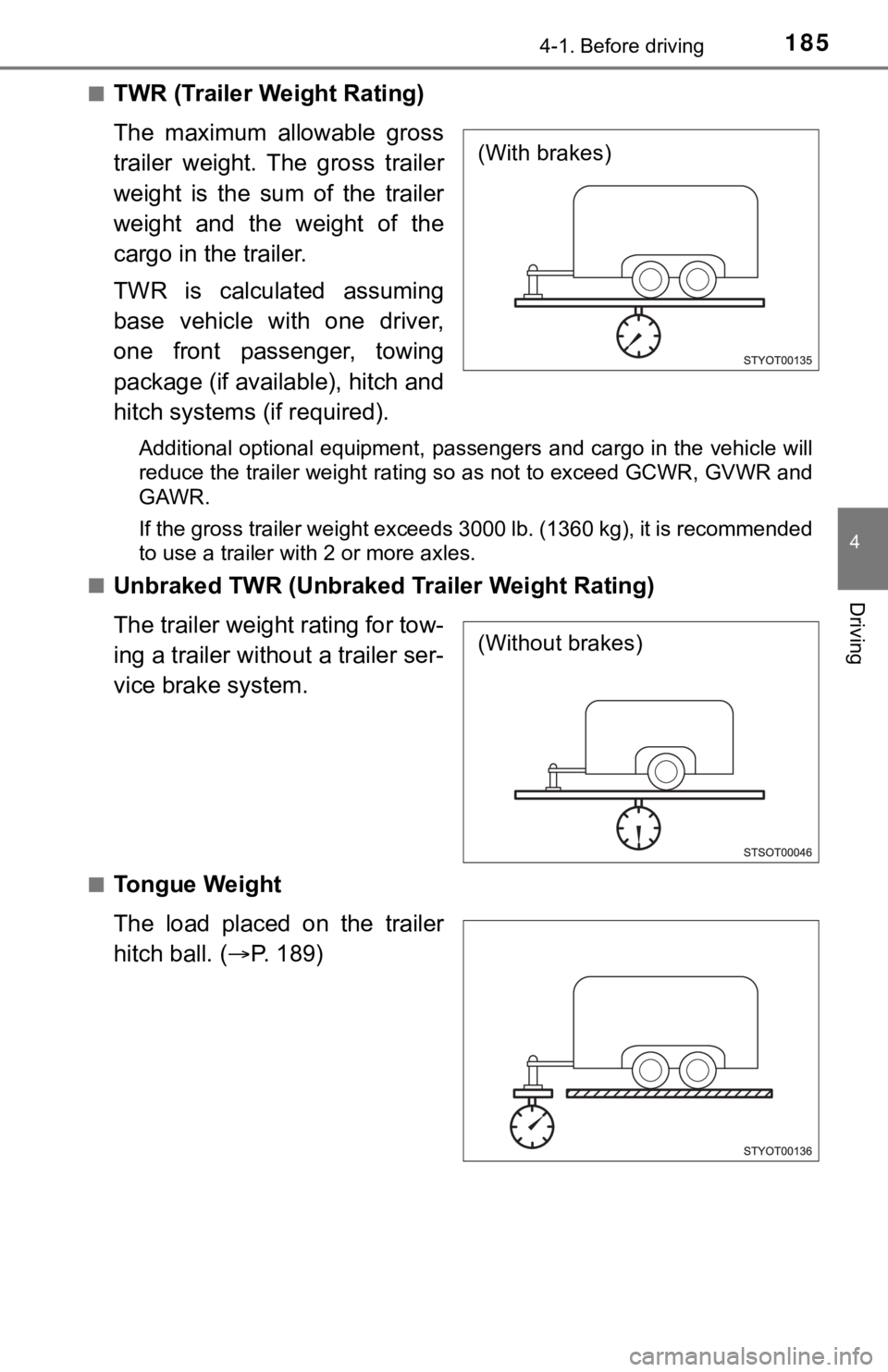
1854-1. Before driving
4
Driving
■TWR (Trailer Weight Rating)
The maximum allowable gross
trailer weight. The gross trailer
weight is the sum of the trailer
weight and the weight of the
cargo in the trailer.
TWR is calculated assuming
base vehicle with one driver,
one front passenger, towing
package (if available), hitch and
hitch systems (if required).
Additional optional equipment, passengers and cargo in the vehicle will
reduce the trailer weight rating so as not to exceed GCWR, GVWR and
GAWR.
If the gross trailer weight exceeds 3000 lb. (1360 kg), it is r ecommended
to use a trailer with 2 or more axles.
■
Unbraked TWR (Unbraked Trailer Weight Rating)
The trailer weight rating for tow-
ing a trailer without a trailer ser-
vice brake system.
■Tongue Weight
The load placed on the trailer
hitch ball. ( P. 189)
(With brakes)
(Without brakes)
Page 186 of 616
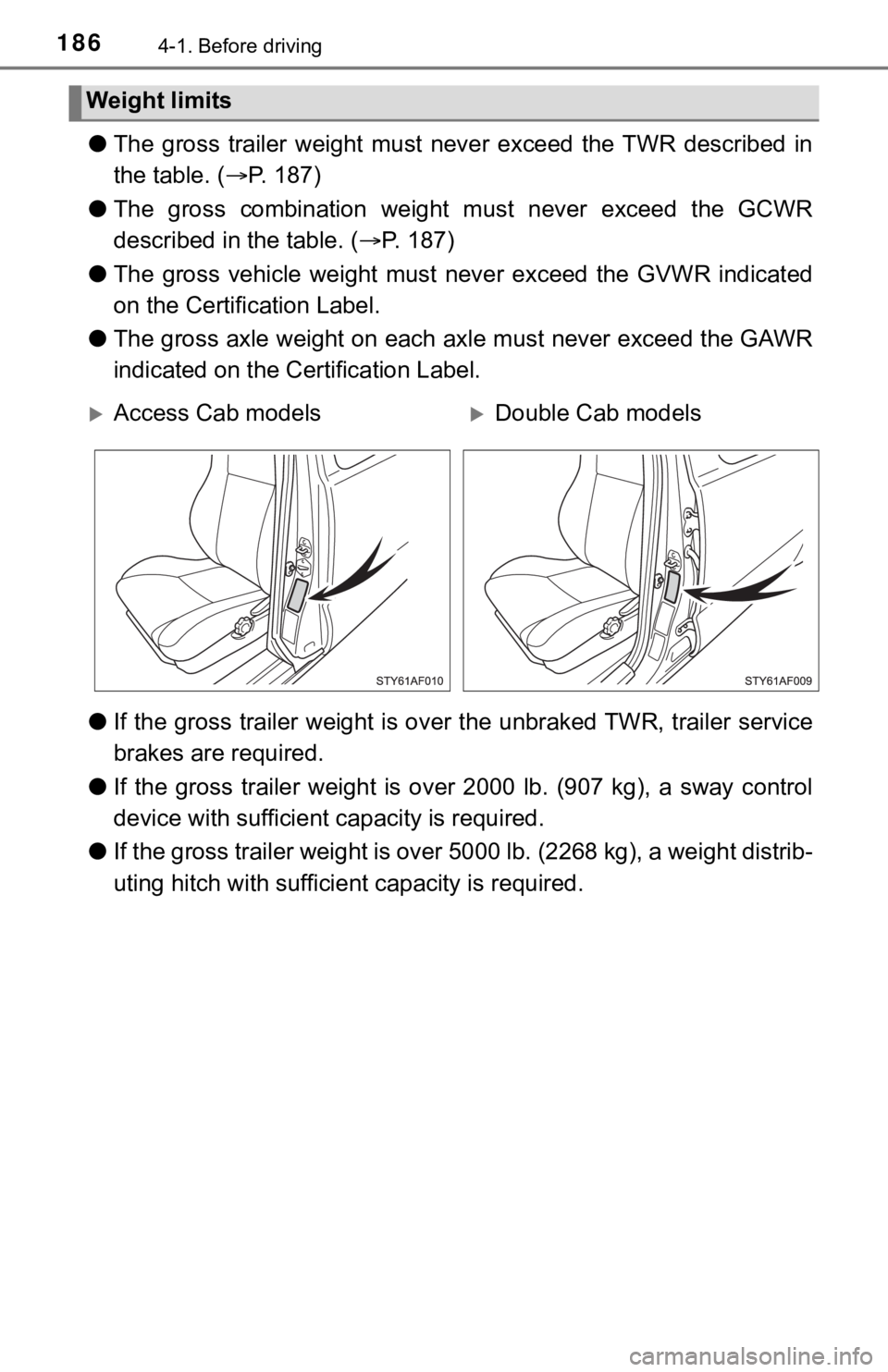
1864-1. Before driving
●The gross trailer weight must never exceed the TWR described in
the table. ( P. 1 8 7 )
● The gross combination weight must never exceed the GCWR
described in the table. ( P. 1 8 7 )
● The gross vehicle weight must never exceed the GVWR indicated
on the Certification Label.
● The gross axle weight on each axle must never exceed the GAWR
indicated on the Certification Label.
● If the gross trailer weight is over the unbraked TWR, trailer s ervice
brakes are required.
● If the gross trailer weight is over 2000 lb. (907 kg), a sway c ontrol
device with sufficient capacity is required.
● If the gross trailer weight is over 5000 lb. (2268 kg), a weigh t distrib-
uting hitch with suffici ent capacity is required.
Weight limits
Access Cab modelsDouble Cab models
Page 187 of 616
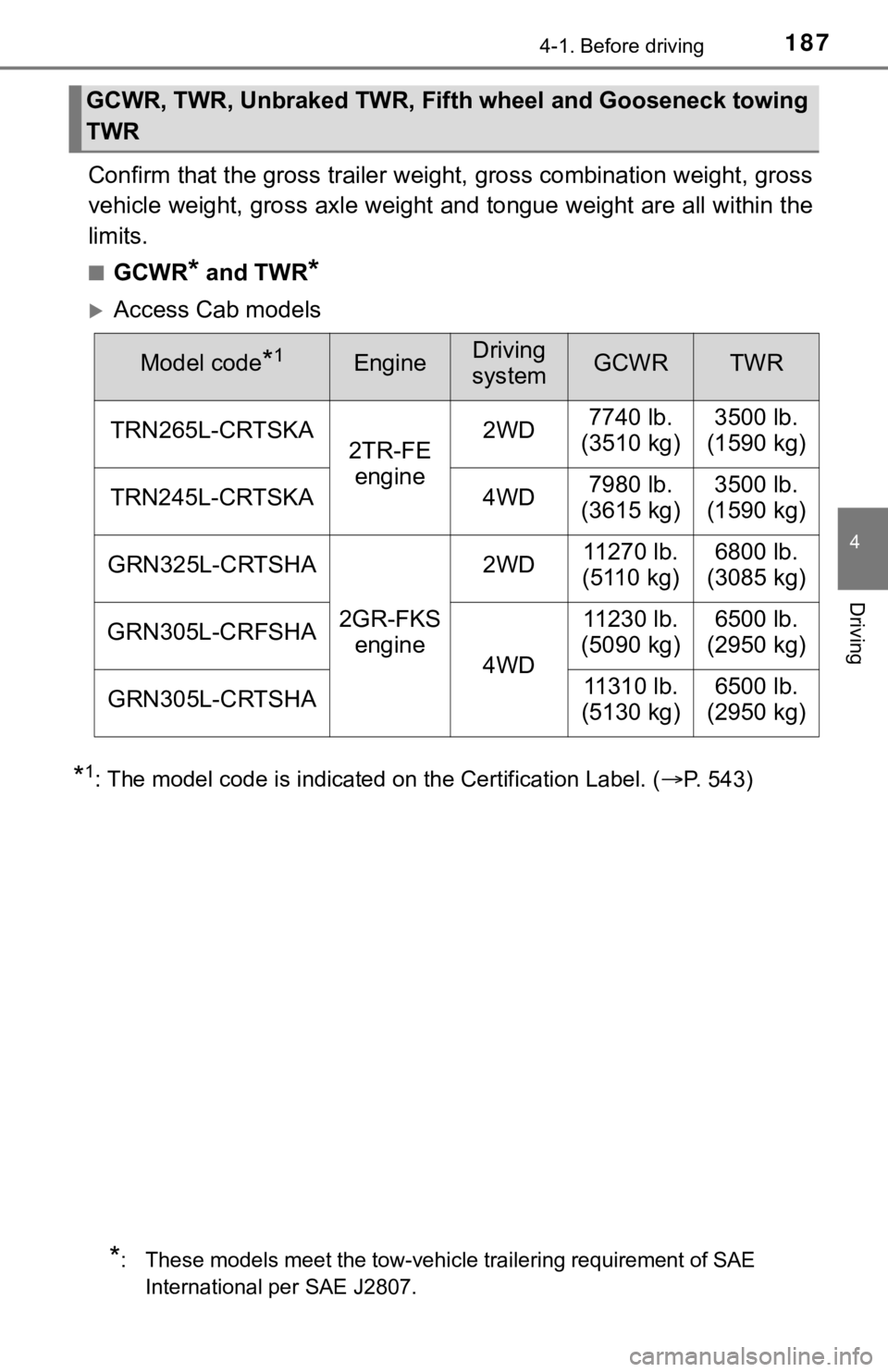
1874-1. Before driving
4
Driving
Confirm that the gross trailer weight, gross combination weight, gross
vehicle weight, gross axle weight and tongue weight are all within the
limits.
■GCWR* and TWR*
Access Cab models
*1: The model code is indicated on the Certification Label. (P. 543)
GCWR, TWR, Unbraked TWR, Fifth wheel and Gooseneck towing
TWR
*: These models meet the tow-vehicle trailering requirement of SAE International per SAE J2807.
Model code*1EngineDriving
systemGCWRTWR
TRN265L-CRTSKA 2TR-FE
engine 2WD
7740 lb.
(3510 kg) 3500 lb.
(1590 kg)
TRN245L-CRTSKA 4WD7980 lb.
(3615 kg) 3500 lb.
(1590 kg)
GRN325L-CRTSHA 2GR-FKS engine 2WD
11270 lb.
(5110 kg) 6800 lb.
(3085 kg)
GRN305L-CRFSHA 4WD11230 lb.
(5090 kg) 6500 lb.
(2950 kg)
GRN305L-CRTSHA 11310 lb.
(5130 kg) 6500 lb.
(2950 kg)
Page 188 of 616
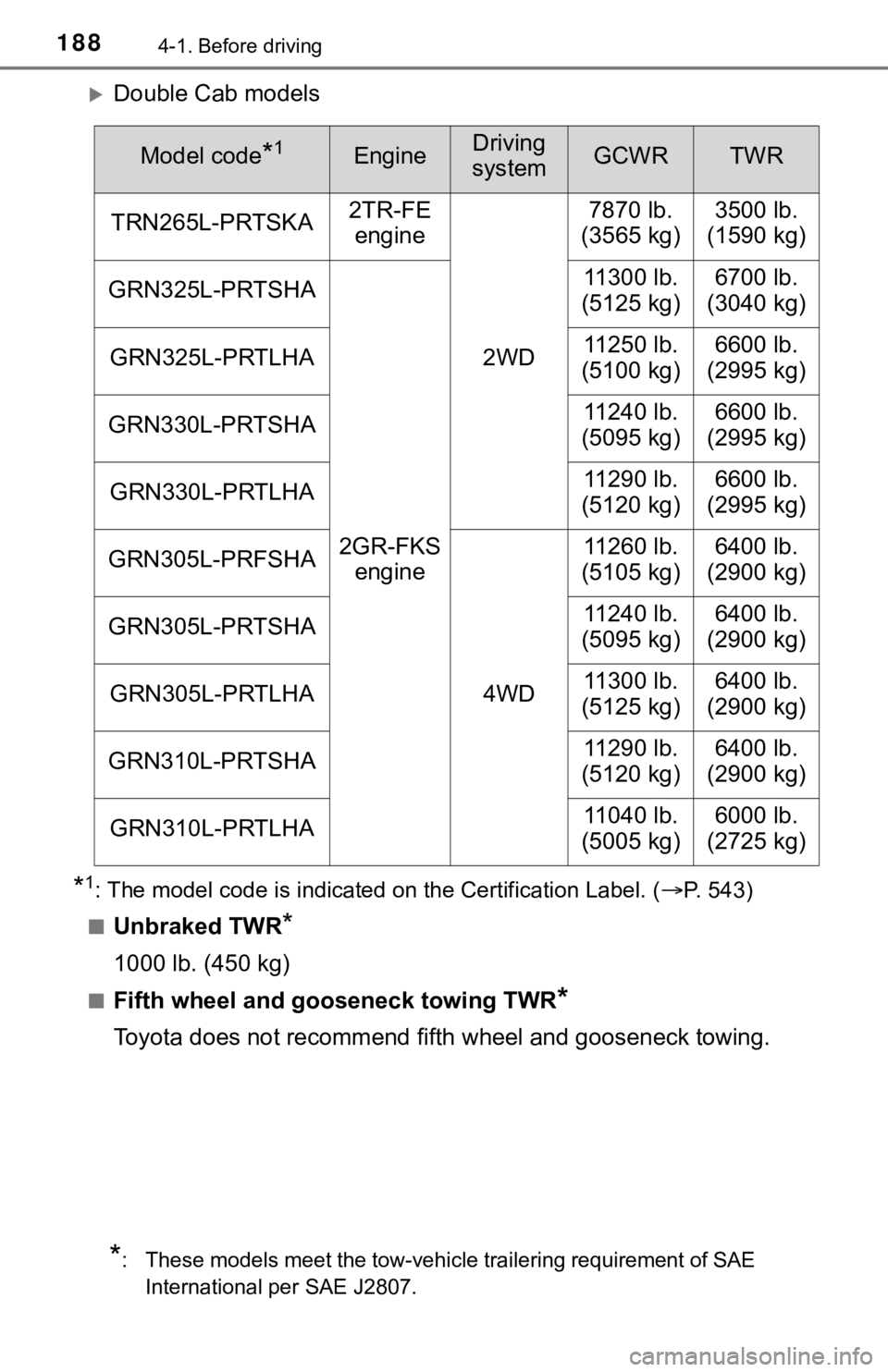
1884-1. Before driving
Double Cab models
*1: The model code is indicated on the Certification Label. (P. 543)
■Unbraked TWR*
1000 lb. (450 kg)
■Fifth wheel and gooseneck towing TWR*
Toyota does not recommend fifth wheel and gooseneck towing.
Model code*1EngineDriving
systemGCWRTWR
TRN265L-PRTSKA 2TR-FE
engine
2WD7870 lb.
(3565 kg) 3500 lb.
(1590 kg)
GRN325L-PRTSHA
2GR-FKS engine 11300 lb.
(5125 kg)
6700 lb.
(3040 kg)
GRN325L-PRTLHA 11250 lb.
(5100 kg)6600 lb.
(2995 kg)
GRN330L-PRTSHA 11240 lb.
(5095 kg)6600 lb.
(2995 kg)
GRN330L-PRTLHA 11290 lb.
(5120 kg)6600 lb.
(2995 kg)
GRN305L-PRFSHA
4WD11260 lb.
(5105 kg)
6400 lb.
(2900 kg)
GRN305L-PRTSHA 11240 lb.
(5095 kg)6400 lb.
(2900 kg)
GRN305L-PRTLHA 11300 lb.
(5125 kg)6400 lb.
(2900 kg)
GRN310L-PRTSHA 11290 lb.
(5120 kg)6400 lb.
(2900 kg)
GRN310L-PRTLHA 11040 lb.
(5005 kg)6000 lb.
(2725 kg)
*: These models meet the tow-vehicle trailering requirement of SAE
International per SAE J2807.
Page 189 of 616
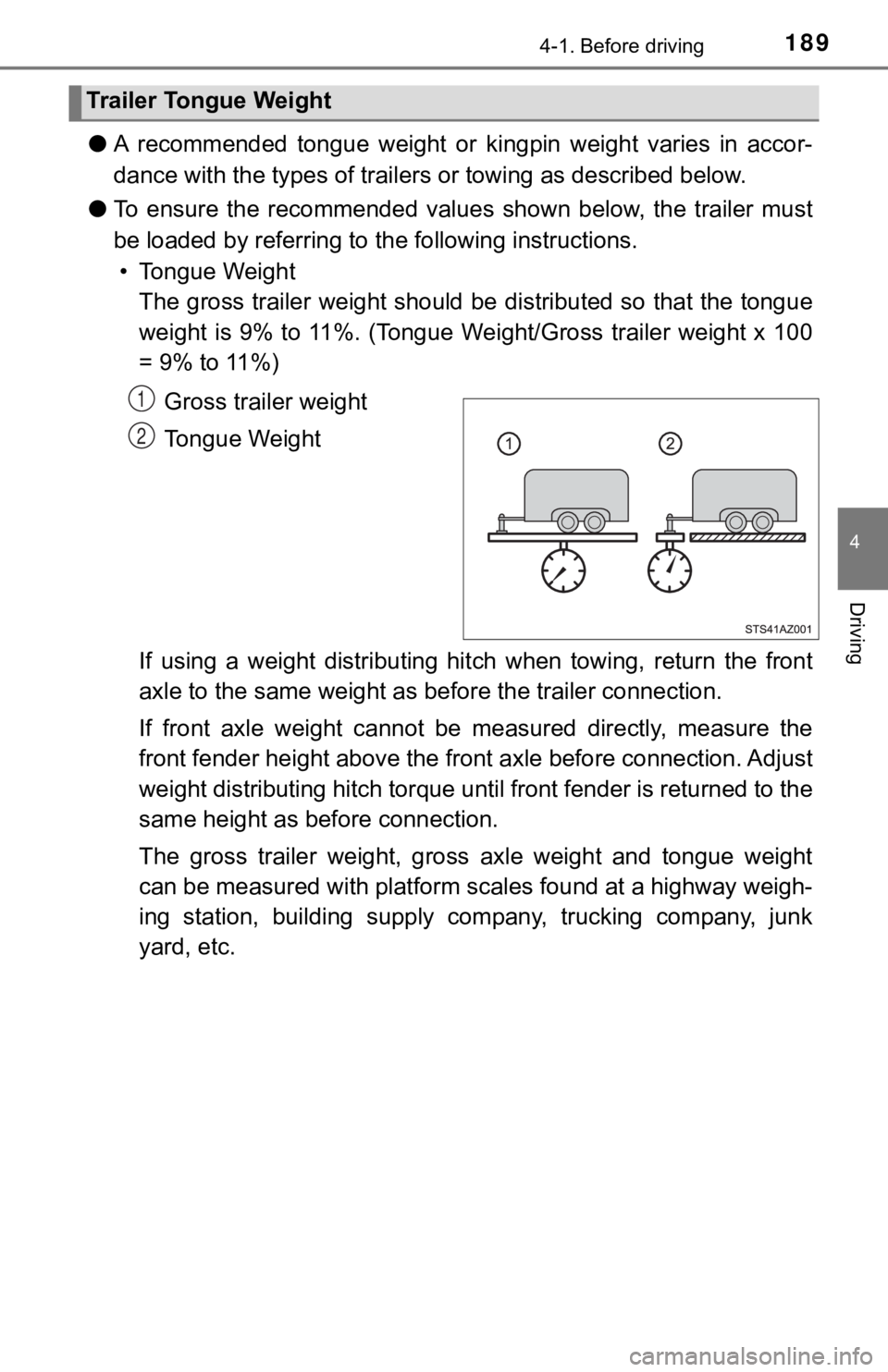
1894-1. Before driving
4
Driving
●A recommended tongue weight or kingpin weight varies in accor-
dance with the types of trailer s or towing as described below.
● To ensure the recommended values shown below, the trailer must
be loaded by referring to t he following instructions.
• Tongue Weight The gross trailer weight should be distributed so that the tong ue
weight is 9% to 11%. (Tongue We ight/Gross trailer weight x 100
= 9% to 11%)
Gross trailer weight
Tongue Weight
If using a weight distributing hi tch when towing, return the front
axle to the same weight as b efore the trailer connection.
If front axle weight cannot be measured directly, measure the
front fender height above the front axle before connection. Adjust
weight distributing hitch torque until front fender is returned to the
same height as b efore connection.
The gross trailer weight, gross axle weight and tongue weight
can be measured with platform sca les found at a highway weigh-
ing station, building supply company, trucking company, junk
yard, etc.
Trailer Tongue Weight
1
2
Page 190 of 616
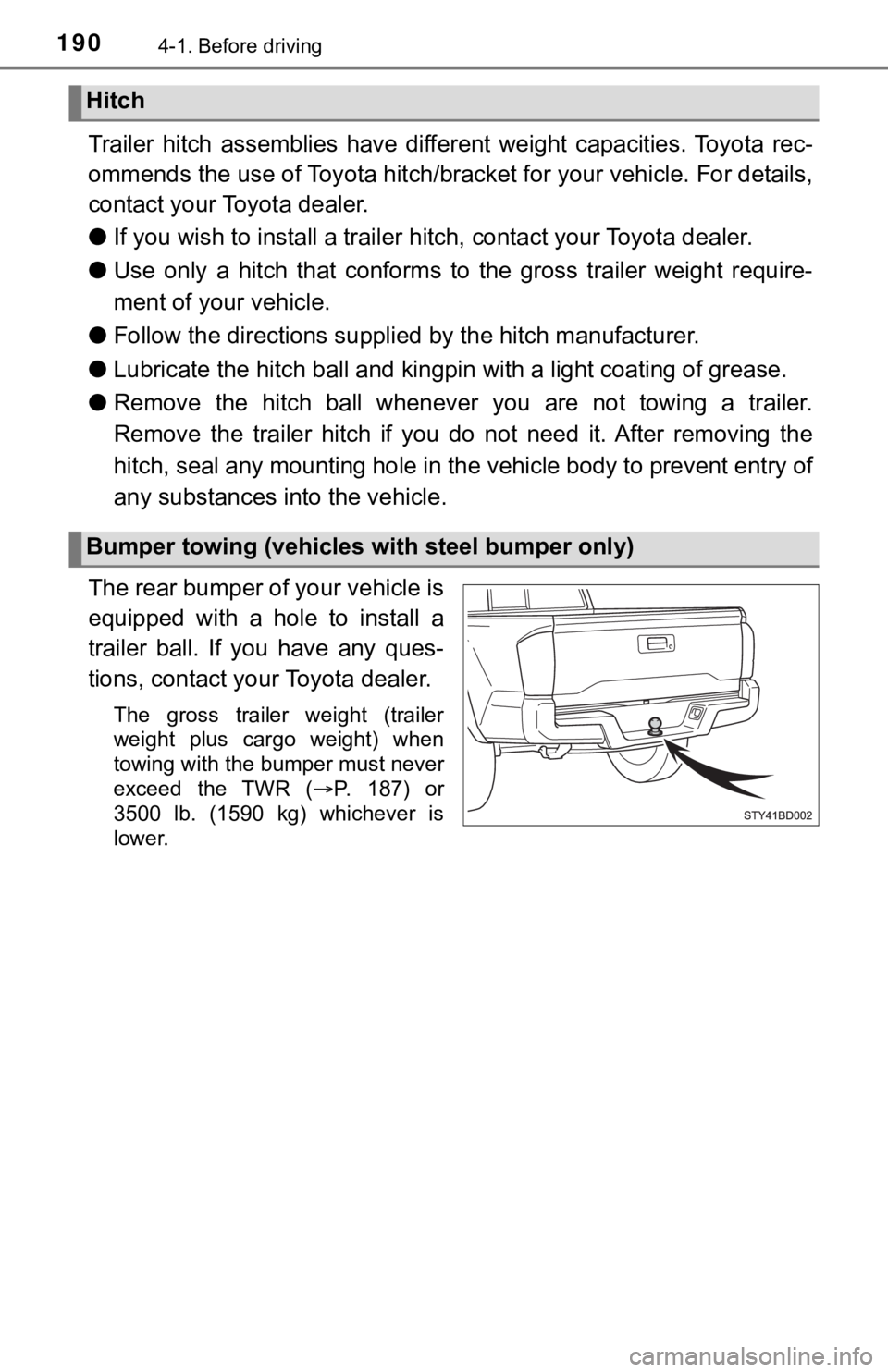
1904-1. Before driving
Trailer hitch assemblies have different weight capacities. Toyota rec-
ommends the use of Toy ota hitch/bracket for your vehicle. For d etails,
contact your Toyota dealer.
● If you wish to install a trailer hitch, contact your Toyota dea ler.
● Use only a hitch that conforms to the gross trailer weight requ ire-
ment of your vehicle.
● Follow the directions suppli ed by the hitch manufacturer.
● Lubricate the hitch ball and kingpin with a light coating of gr ease.
● Remove the hitch ball whenever you are not towing a trailer.
Remove the trailer hitch if you do not need it. After removing the
hitch, seal any mounting hole in the vehicle body to prevent en try of
any substances into the vehicle.
The rear bumper of your vehicle is
equipped with a hole to install a
trailer ball. If you have any ques-
tions, contact yo ur Toyota dealer.
The gross trailer weight (trailer
weight plus cargo weight) when
towing with the bumper must never
exceed the TWR ( P. 187) or
3500 lb. (1590 kg) whichever is
lower.
Hitch
Bumper towing (vehicles with steel bumper only)